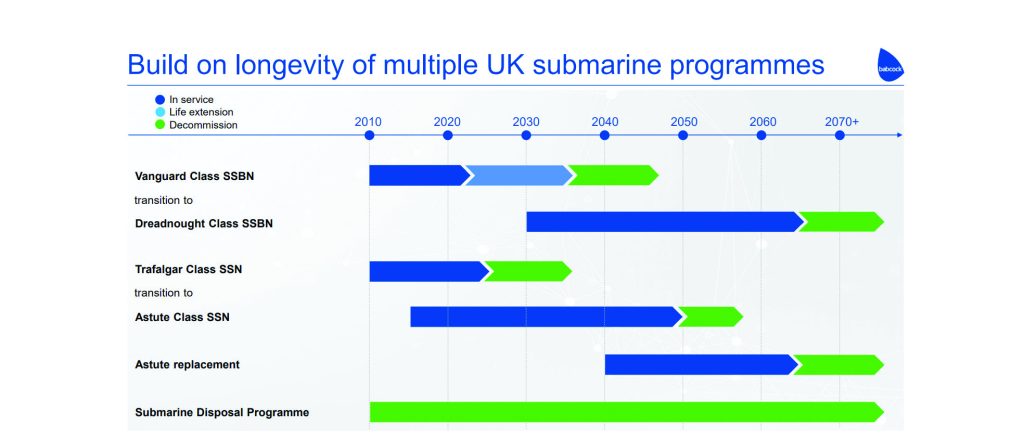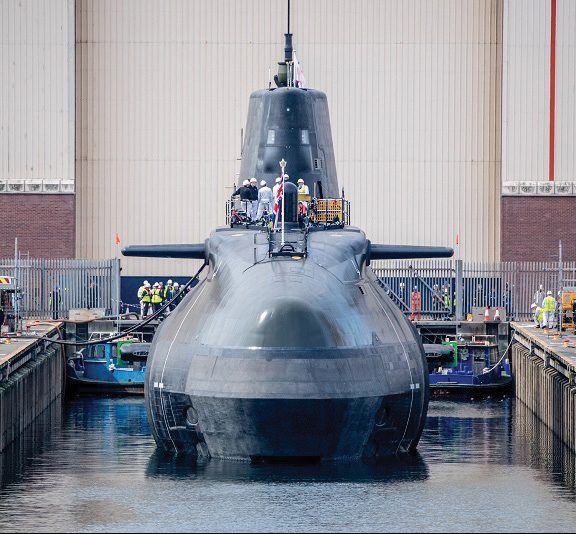
BAE Systems is the industrial lead in the Dreadnought Alliance alongside partners Ministry of Defence, Rolls-Royce and the Submarine Delivery Agency, to deliver the Dreadnought programme—a new generation of 4 nuclear-powered Royal Navy submarines to carry the UK’s independent nuclear deterrent.
Few UK sectors have visibility of future demand that the UK submarine industrial base enjoys, the Babcock table below outlines what may be available to capitalize on. These Long-term programmes provide a firm foundation for our growing our own skills locally, bringing specialists in and creating more prosperity through new jobs and supply chain company activity.
Dreadnought build, currently in Delivery Phase 3 since May 2022 is one of the largest and most complex engineering projects in the world.2
As “A National Endeavour”, it will support almost 30,000 UK jobs at its peak including 8,000 employed directly by BAE Systems. It is estimated that around half of these jobs are in the North West of England, therefore making a significant contribution to the Government’s LevellingUp and UK Shared Prosperity priorities and outcomes from investment in defence.
The Dreadnought boats will be the largest submarines ever built for the Royal Navy with a displacement of around 17,200 tonnes. They may be around 153.6 metres long. They will begin to replace the current Vanguard class in the 2030s, ushering in a new era of at-sea deterrence, protecting the nation well into the 2060s’, providing the ultimate guarantee of UK’s national security. Work on the first two boats in the class— Dreadnought and Valiant—is taking place at Barrow shipyard, where nearly 9,500 employees work on the Dreadnought and Astute submarine programmes. Boats 3 and 4 are to be named as Warspite and King George V1.
Dreadnought will be equipped with a new generation of nuclear reactor (PWR 3) to provide power and propulsion which operates “as quietly as an idling car”.
Dreadnought must be able to navigate and remain undetected for months on end, maintain communications with shore authorities at all times, and be able to defend itself. The design therefore incorporates a range of sophisticated electronic systems, sensors and tactical weapons. The design must also minimise noise and vibration so that it can remain undetected by sonar.
Over 130 men and women of the Royal Navy will operate the submarine each time it sails on patrol and must work, eat, sleep and exercise in the unique confines of a dived submarine at sea for many weeks. This is a once-in-a-generation opportunity to boost education, infrastructure and technology, to enhance the UK’s maritime supply chain and sustain one of our most critical defence capabilities.
In 2016 a £1.3bn contract was signed for Delivery Phase 1 (DP1), steel was cut on the first boat and the class was named Dreadnought. In 2018, a £900m contract for Delivery Phase 2 (DP2) was signed. Delivery Phase 3 (DP3) was announced in May 2022. Babcock was in 2020 contracted to deliver 75 missile tubes for the UK and American submarines.

The UK submarine based deterrent capability aims to provide Britain with “ A minimum, credible, independent nuclear deterrent, based on a continuous at sea posture and assigned to the defence of NATO, remains essential as the ultimate guarantee to our security, and that of our allies.” Defence in a Competitive Age policy, (para 4.11) March 2021 Since April 1969, there has always been a Royal Navy ballistic missile submarine at sea on deterrent patrol.
Armed with strategic nuclear missiles, these submarines have acted as the nation’s continuous nuclear deterrent against the most extreme threats to the UK and our allies, by sending a clear message to would-be aggressors. Extreme threats to the UK and our allies have not gone away. Some nuclear-armed states are increasing and diversifying their arsenals, while increases in global competition, challenges to the multilateral order, and proliferation of potentially disruptive technologies all pose a threat to strategic stability. The UK must ensure potential adversaries can never use their capabilities to threaten us or our NATO allies, to constrain our decision making in a crisis, or to sponsor nuclear terrorism. UK has committed to a once-in-two-generations programme to modernise its nuclear forces, replacing the current Vanguard Class submarines with four new Dreadnought Class submarines.
Designed and built in the UK, these new submarines will deliver formidable capability. The UK will also replace the UK’s nuclear warheads to ensure it maintains an effective deterrent. UK Government policy is to work collaboratively across the nuclear sector to optimise the Defence Nuclear Enterprise for the future, ensuring that the UK retains and develops its world leading skills through a wide range of companies. UK Government also remains committed to the long-term goal of a world without nuclear weapons and continue to work for the preservation and strengthening of effective arms control, disarmament, and non-proliferation measures, taking into account the prevailing security environment.

For further information please contact
The Secretariat, Keep Our Future Afloat,
28, Lancaster Street, Dalton in Furness LA158SD
Call: 07836 254721
Email: stuart@klosinski.co.uk

Website designed by Furness Media.